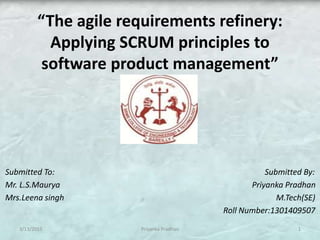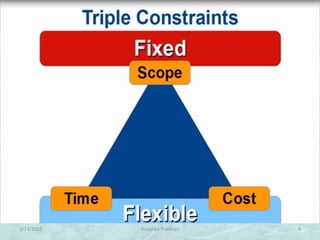The agile requirements refinery(SRUM) by: Priyanka Pradhan
- 1. ŌĆ£The agile requirements refinery: Applying SCRUM principles to software product managementŌĆØ Submitted To: Submitted By: Mr. L.S.Maurya Priyanka Pradhan Mrs.Leena singh M.Tech(SE) Roll Number:1301409507 13/13/2015 Priyanka Pradhan
- 2. Content ŌĆó Abstract ŌĆó Paper Description ŌĆó Conclusion 3/13/2015 Priyanka Pradhan 2
- 3. Abstract ŌĆó Context: Although agile software development methods such as SCRUM is gaining popularity, the consequences of applying agile principles to software product management have received little attention until now. ŌĆó Objective: In this paper, this gap is filled by the introduction of a method for the application of SCRUM principles to software product management. ŌĆó Method: A case study research approach is employed to describe and evaluate this method. ŌĆó Results: This has resulted in the ŌĆśagile requirements refineryŌĆÖ, that enables product managers to cope with complex requirements in an agile development environment. A case study is presented to illustrate how agile methods can be applied to software product management. ŌĆó Conclusions: The experiences of the case study company are provided as a set of lessons learned that will help others to apply agile principles to their software product management process. 3/13/2015 Priyanka Pradhan 3
- 33. 3/13/2015 Priyanka Pradhan 33
- 35. Conclusion SCRUM development method shows that an agile development process implies an environment that is dynamic and to which it is constantly adapting, be it in a controlled, effective way. It is not hard to imagine that such a dynamic development environment requires an SPM process that is adequately adapted to this. The effect of this is an increased demand for agile SPM processes. The main contribution of this work has been the description of an innovative SPM process based on agile principles. The textual description along with process-deliverable diagrams both for the software development as well as the SPM processes allows effective reuse of the described method in other companies that find themselves in a comparable situation. 3/13/2015 Priyanka Pradhan 35
- 37. Thank You 3/13/2015 Priyanka Pradhan 37





































